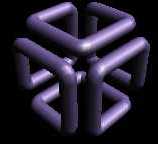


 |

|

|
|
Final Exam Review ProblemsThe following problems will be similar to the type of problems that will be on the exam. However, not all problems on the exam are necessarily represented here, and not all the types of problems here will necessarily be on the exam.
Problem 1: Clipping
(xmax, ymax) = (6, 4) For the pairs of points in parts a and b, indicate the outcodes for Cohen-Sutherland outcode for each point. State what the algorithm will dictate concerning the rendering or the line-segment (entirely rendered, clipped with part rendered, entirely clipped (i.e. not rendered) or not known), and briefly state why the algorithm gives this output. If clipping is required, or if it is not known, calculate the intersection points to determine where to clip. a) P0 = (2, 3), P1 = (5, 5) b) P0 = (7, 1), P1 = (8, 3) c) For the following pair of points, determine the clipping values using Liang-Barsky clipping. Indicate whether the line is discarded entirely, rendered entirely, or clipped. If the line is clipped, indicate the (x, y) value(s) at which it is clipped. P0 = (4, 3), P1 = (5,1)
Problem 2: Line Drawing
(x2, y2) = (6,4) a) The DDA algorithm? b) The Bresenham algorithm. (Show your work, indicating the values of dk at each step). c) Which of the 2 algorithms is preferred and why?
Problem 3: Curves
P1 = (3, 5, 2) P2 = (5, 5, 3) P3 = (8, 2, 4) Problem 4: The LookAt function
Answer the following questions: a) What is the VRP (view reference point)? b) What is VPN (view plane normal)? c) What is VUP (view-up vector)? d) If the image plane is defined by vectors v and u described in the book (p. 206), does VUP equal v? Why or why not? (You should not have to calculate v exactly to answer this question). Problem 5: (Not a problem, but more things to study)
Home | | Syllabus | | Assignments | | Documentation
Constance Royden--croyden@mathcs.holycross.edu
|